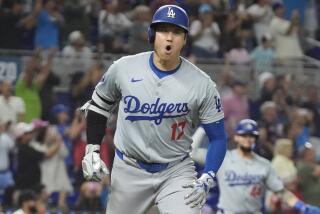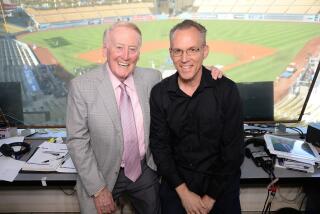The home run that launched the myth of Mickey Mantle
It was the first inning, one runner aboard, the count at two balls and two strikes, and Tom Lovrich stared down the 19-year-old rookie batter.
USC’s junior ace didn’t know much about him, except that he more than filled out his gray New York Yankees uniform.
“He was a strong, country kid from Oklahoma,” Lovrich said, recalling the legendary at-bat that took place 60 years ago Saturday. “Very strong.”
Lovrich figured the rookie would chase something low and away for strike three, so the 6-foot-5 right-hander known as “Tall Tom” began his sidearm windup and fired.
His head sank as soon he heard the devastating crack of the wooden bat.
“My God,” said USC second baseman Stan Charnofsky, watching the ball scream over the wire fence in right-center field. “Look at that.”
USC’s football practice field ran adjacent to Bovard Field. The ball bounced at midfield and rolled into a huddle.
“Who the hell hit that?” one player asked.
And as they walked off the field, their spring practice complete, another football player learned the answer to that question and told the others.
“Some kid named Mickey Mantle.”
Introducing himself
The black-and-white clip is grainy, but the narrator’s voice is sharp and upbeat:
“It’s big league baseball on Bovard Field as the Trojans become the first college team ever to host a world champion,” he begins. “The guests of the day: the New York Yankees.”
The myth of Mantle and the legend of “The Mick” began at USC that day.
The Yankees visited as a favor to USC Coach Rod Dedeaux, who played for Yankees Manager Casey Stengel when Stengel managed the Brooklyn Dodgers. Dedeaux also had three former players who were Yankees rookies.
The afternoon game was the finale in the Yankees’ rare, 13-game spring-training swing in California. They drew huge crowds at every stop — about 140,000 fans in all, according to The Times’ account — and extra seating had been erected at Bovard to increase capacity to 3,000.
The 1-minute 13-second newsreel clip from the 1951 Trojan Review shows at least that many.
They sat shoulder-to-shoulder, men in collared shirts and women in full skirts. Many wide-eyed students leaned over railings.
Some came to see the big names, catcher Yogi Berra, shortstop Phil Rizzuto and center fielder Joe DiMaggio. The trio of stars were on the cover of the game scorecard, just below a large illustration of Stengel’s face.
But there was also plenty of curiosity about the player being groomed to fill DiMaggio’s shoes, a 5-foot-11, 185-pounder who made the uncommon leap to the Yankees from Class C baseball in Joplin, Mo.
Mantle had yet to take an official major league swing, but he had astonished fans all spring, hitting one tape-measure home run after another, going from unknown to boy wonder with every awesome drive.
“Even the players gathered when he took batting practices every day, and they were as awed as the people in the seats,” author David Halberstam wrote in the book “October 1964.”
Mantle didn’t disappoint against the Trojans, going four for five with a single, a triple, two home runs and seven runs batted in.
“Mickey Mantle practically dismantled the Trojans all by himself,” The Times’ story began the next morning, under the headline “Yankees Dismantle Troy in 15-1 Rout.”
“The greatest show in history,” Dedeaux later said.
Jane Leavy, in her book about Mantle titled “The Last Boy,” called it “the day Mantle announced himself to the world.”
He did it with that first-inning drive that might have been the longest home run of his career.
‘We’ll see what happens’
In the Yankees’ dugout before the game, Rizzuto, the 1950 American League MVP, called down the bench to Mantle.
“Hey, rook,” Rizzuto said, “I’ve got someone down here about your age.”
Mantle came over and plopped down next to Justin Dedeaux. Rod’s 7-year-old son was USC’s bat boy.
The two joked around, but Justin didn’t know a thing about Mantle and was really waiting to to see his favorite player, DiMaggio.
And when DiMaggio emerged from the building where the Yankees dressed, Justin trembled. “It was like God, God himself, walked out,” he recalled.
Mantle, the son of a coal miner, was far from that, looking more like one of USC’s players with his blond hair and boyish smile.
But physically he was stocky, broad through the chest with thick arms and legs. He was built more like a running back than an outfielder.
“Everything about him looked powerful,” said Dave Rankin, then a sophomore reliever for USC.
Rod Dedeaux didn’t tell his pitchers much except that Mantle could hit for power.
“So he said what he said about every power hitter,” Rankin remembered. “‘Keep the ball down, and we’ll see what happens.’”
Nothing worked. Both of Mantle’s two-run home runs — one from each side of the plate — traveled at least 500 feet, according to legend.
The longer of the two was Mantle’s first, and it came on a pitch about eight inches off the ground, Lovrich said.
Bob Hertel, who started in left field for USC that day, swore that ball became flat on one side after the barrel of Mantle’s bat made contact.
“It had to be, to hit a ball that hard and that far,” said Hertel, 81.
The question is, how far?
Going the distance
Like caught fish, home runs grow as tales are told. The distance of Mantle’s first-inning home run has long been debated.
Satellite imagery was even used in an effort to pinpoint the ball’s trajectory.
Interviews with witnesses to Mantle’s display that day reveal different estimates. Some are as long as 660 feet, and most concede the blast went at least 550.
Home plate at Bovard, which closed in 1974, is now the site of a grassy gully behind USC’s Annenberg School for Communication & Journalism.
The dimensions at Bovard were 307 feet down the left-field line, 351 to left-center, 439 to center, 344 to right-center and 318 down the right-field line, Justin Dedeaux said.
Most witnesses say Mantle hit the ball to right-center, toward the corner of what is now Watt Way and West 34th Street. If it landed near there, an estimate of 600 or more feet would be reasonable.
Frank Gifford, then a USC tailback, said the ball landed near the middle of the football practice field.
“No one had ever done that before,” he said.
Gifford’s testimony debunks myths that it hit the street or the Methodist church beyond the street, and he laughed at one particularly gaudy 656-foot estimate.
Whatever the exact length, it is said to be the longest home run in the history of Bovard.
As soon as Mantle hit it, Justin Dedeaux’s allegiance switched from DiMaggio to “Mick,” and he wore No. 7 as a second baseman at USC in Mantle’s honor.
“After that day, he was my man,” said Justin, 67. “I followed him every day for the rest of his career.”
A picture commemorating Mantle’s feat hangs in USC’s Baseball Hall of Fame.
Mantle returned to USC for a celebrity game in the mid-’70s, Justin remembered. Mantle had retired from baseball in 1968, finishing his 18-season career with 536 home runs.
But Mantle still looked in shape and even hit a few out of USC’s new Dedeaux Field, named after Justin’s father, where the Trojans began playing in 1974.
Justin remembered Mantle laughing as he recalled his first game on campus, thinking of all the coeds who adored him and joking that he should have gone to school at USC.
Mantle talked about his home runs too.
“I really got a hold of a couple,” he told Justin. “Man, that was fun.”
More to Read
Go beyond the scoreboard
Get the latest on L.A.'s teams in the daily Sports Report newsletter.
You may occasionally receive promotional content from the Los Angeles Times.










